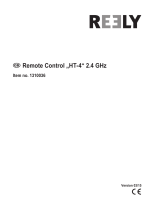
2
Table of Contents
1. Introduction .......................................................................................................................................................... 3
2. Explanation of Symbols .......................................................................................................................................3
3. Intended Use .......................................................................................................................................................4
4. Product Description .............................................................................................................................................4
5. Scope of Delivery .................................................................................................................................................4
6. Safety Information ................................................................................................................................................5
a) General Information .......................................................................................................................................5
b) Operation .......................................................................................................................................................6
7. Notes on Batteries and Rechargeable Batteries ..................................................................................................7
8. Charging Rechargeable Batteries ........................................................................................................................7
9. Transmitter Controls ............................................................................................................................................8
10. Setting up the Transmitter ....................................................................................................................................9
a) Inserting the Batteries ....................................................................................................................................9
b) Switching on the Transmitter .........................................................................................................................9
11. Setting up the Receiver .....................................................................................................................................10
a) Receiver Connection ...................................................................................................................................10
b) Installing the Receiver ................................................................................................................................. 11
12. Installing the Servos ..........................................................................................................................................12
13. Setting the Trim ..................................................................................................................................................12
a) Setting the Steering Trim ............................................................................................................................. 13
b) Setting the Driving Trim ...............................................................................................................................13
14. VericationofSteeringandDrivingFunctions ................................................................................................... 14
a) CheckingandSettingtheSteeringFunction ...............................................................................................14
b) CheckingandSettingtheDrivingFunction .................................................................................................16
15. Fail-SafeFunction ..............................................................................................................................................17
16. Switching the Digital Code ................................................................................................................................. 18
17. BindingFunction ................................................................................................................................................ 19
18. SimulatorFunction ............................................................................................................................................. 20
19. Maintenance and Care ......................................................................................................................................20
20. Disposal ............................................................................................................................................................. 21
a) Product ........................................................................................................................................................21
b) Batteries ......................................................................................................................................................21
21. Declaration of Conformity (DOC) ....................................................................................................................... 21
22. Troubleshooting .................................................................................................................................................22
23. Technical Data ...................................................................................................................................................23
a) Transmitter...................................................................................................................................................23
b) Receiver ......................................................................................................................................................23
Page




























